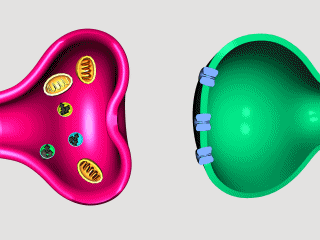Tuesday, April 16, 2019
Easy to see
Mitochondria are the main 'digesters' in a cell, and also get involved in other activities. They're especially numerous in the axon (output) of a neuron, where they help to generate the neurotransmitter chemicals that trigger a response in the dendrite (input) of other neurons.
 Because neurons are semi-permanent, only regenerating at certain times and places, they need more maintenance than disposable skin cells. So the health of all internal parts is crucial.
Via ScienceDaily, a new finding by researchers who are focusing on the role of mitochondria in Parkinson's.
Because neurons are semi-permanent, only regenerating at certain times and places, they need more maintenance than disposable skin cells. So the health of all internal parts is crucial.
Via ScienceDaily, a new finding by researchers who are focusing on the role of mitochondria in Parkinson's.
 Because neurons are semi-permanent, only regenerating at certain times and places, they need more maintenance than disposable skin cells. So the health of all internal parts is crucial.
Via ScienceDaily, a new finding by researchers who are focusing on the role of mitochondria in Parkinson's.
Because neurons are semi-permanent, only regenerating at certain times and places, they need more maintenance than disposable skin cells. So the health of all internal parts is crucial.
Via ScienceDaily, a new finding by researchers who are focusing on the role of mitochondria in Parkinson's.
When mitochondria become damaged, they avoid causing further problems by signaling cellular proteins to degrade them. In a new study, scientists report that they have discovered how the cells trigger this process, which is called mitophagy. In cells with broken mitochondria, two proteins -- NIPSNAP 1 and NIPSNAP 2 -- accumulate on the mitochondrial surface, functioning as 'eat me' signals, recruiting the cellular machinery that will destroy them.It's easy to see how this mechanism developed by random selection. The 'eat me' signal was always present on mitochondria, but until the 'eating' mechanism happened to develop by random selection, cells didn't survive.... Oops. Try again. Random selection developed the 'eater' that knew how to read the 'eat me' proteins, and then these cells died because excess unproductive mitochondria piled up, until after billions of years and billions of mutations in these cells that didn't survive in the first place, one lucky mitochondrion learned to produce the particular protein that signaled 'eat me'. This lucky mitochondrion was then immediately eaten, so its lucky talent didn't get passed on to the mitochondria in the cells that didn't exist because they hadn't survived in the first place. Ooops.
Labels: Grand Blueprint, Loughnerian Logic
